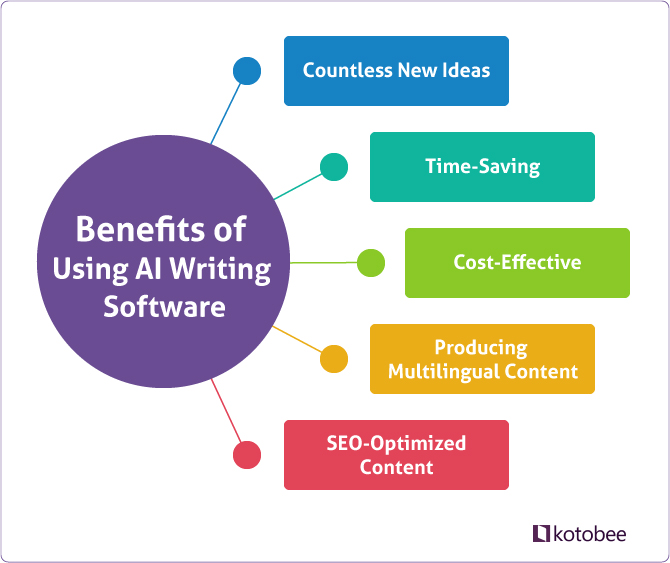AI Writing Assistants: How They Are Transforming Content Creation

Are you tired of feeling like Neo from The Matrix, endlessly typing away at your keyboard with no end in sight? Fear not, because AI writing assistants are here to help you break free from the “matrix” of writing inefficiency.
With their natural language processing and machine learning algorithms, these writing assistants can improve your grammar, spelling, and sentence structure, and even generate entire pieces of content. And as the demand for content creation increases, the need for AI writing assistants only grows stronger.
The AI writing assistant software market is booming, with a value of USD 818.48 Million in 2021 and a projected reach of USD 6,464.31 Million by 2030. It’s slated to grow at a whopping CAGR of 26.94% from 2023 to 2030. You surely wouldn’t want to miss out on this thrilling ride!
So let’s take the red pill and explore the world of AI writing assistants, their pros and cons, and how you can integrate them into your writing workflow to become the Neo of content creation.
The Future of Writing: A Glimpse into AI Writing Assistants
The concept of AI writing assistants has been around for several years, but it was not until recently that they began to gain widespread popularity. In the early days, AI writing assistants were basic spelling and grammar checkers, but today they are far more sophisticated. They use machine learning algorithms to analyze large amounts of data, which helps them make more accurate suggestions for improving written content.

Types of AI writing assistants
There are several types of AI Writing Assistants available today, including:
- Grammar and spell checkers: These are the most basic AI writing assistant and are often included as part of word processing software.
- Content generators: These free (or paid) AI writing tools can generate entire pieces of content based on a given topic or set of keywords.
- Style and tone checkers: These AI writing assistants analyze a writer’s style and tone and provide suggestions for improving consistency across multiple pieces of content.
- SEO optimization tools: These free (or paid) AI writing assistants help writers to optimize their content for search engines by suggesting relevant keywords and phrases included in their writing.
AI writing assistants are powerful tools that can help writers to improve the quality of their content and increase productivity.
Types of Content Created by AI Assistants
AI writing assistants are versatile tools that can assist in the creation of various types of content. Some of the types of content that one can write with AI assistance include the following:
- Blog posts: Many businesses and individuals rely on blog posts writing to drive traffic to their websites. An AI writing assistant can help generate ideas for new blog posts, suggest relevant keywords, and even write entire blog posts.
- Social media posts: With the rise of social media, businesses need to produce high volumes of content quickly. An AI copywriting assistant can help create catchy and engaging social media posts that will capture the attention of their target audience.
- Product Descriptions: Writing compelling product descriptions is crucial for e-commerce businesses. AI writing assistants can help businesses create descriptions that highlight the features and benefits of their products, and provide SEO optimization for maximum visibility.
- Newsletters: Email newsletters are an effective way to stay in touch with customers and clients. An AI copywriting assistant can help businesses create newsletters that are engaging and informative, with relevant and timely content.
Revolutionizing Writing: The Role of AI Writing Assistants Today
The way we write has changed dramatically in recent years. In the past, professional writers and marketers would spend hours crafting each piece of content. Today, however, the demand for content has skyrocketed, and businesses and individuals need to produce high volumes of content quickly. This is where AI writing assistants come in. They can help writers produce content faster and more efficiently, allowing them to focus on other aspects of their work.
AI writing assistants are particularly relevant today because they can help businesses and individuals create high-quality content at a lower cost. Instead of hiring a team of writers or outsourcing content creation, businesses can use a free (or paid) AI writing tool to create content in-house, reducing costs and increasing efficiency.
Furthermore, AI writing assistants are continually improving and becoming more sophisticated, with new features and capabilities being added all the time. As AI writing assistants continue to evolve, they will become even more valuable tools for writers, marketers, and businesses looking to create high-quality content at scale.
Finding the Best AI Writing Assistant Software
When it comes to choosing the best AI writing assistant software, there are several popular options to consider. Some of the most well-known AI writing assistants include Grammarly, ProWritingAid, Copyscape, and Peppertype.ai. Each of these tools has its own unique set of features, pricing, and suitability for different needs.
Grammarly is a popular choice for its advanced grammar and spell-checking capabilities, while ProWritingAid offers a more comprehensive set of writing analysis tools. Copyscape is ideal for detecting plagiarism, while Peppertype.ai is a great option for producing high-converting content quickly and efficiently. Let’s dig deeper.
Peppertype.ai is one of the best AI writing assistant software that enables users to create high-quality, engaging content quickly and efficiently. The tool offers a range of features that make content creation a breeze, including the ability to produce emails, long-form content, landing pages, and more, all with high conversion rates.

With advanced algorithms and natural language processing capabilities, users can create long-form content 10 times faster, write SEO-friendly blogs and meta descriptions, and even produce emails in just 30 seconds. Over 100,000 active users have generated more than 5 million content pieces with Peppertype.ai, making it a trusted tool for businesses and individuals looking to streamline content creation. Additionally, the tool’s ability to write landing page copy in under 30 minutes, experiment with multiple ad copies, and repurpose old content quickly makes it an ideal choice for marketers, bloggers, and businesses.
When choosing an AI writing assistant, it’s important to consider factors such as your specific writing needs, budget, and the features most important to you. Some other factors to consider include the tool’s ease of use, customer support, and the level of customization and personalization offered.
From Clumsy to Composed: How to Work with AI Writing Assistants
Integrating AI writing assistants into your workflow can be a game-changer for content creation, but it’s important to use them effectively. Some tips for success include defining your goals, providing clear guidelines and feedback, and testing and adjusting your approach. It’s also important to optimize your use of AI writing assistants by leveraging their strengths and ensuring they align with your brand’s voice and tone.

Challenges can arise when using AI writing assistants, such as errors in output or the risk of losing the personal touch. Overcoming these challenges requires regular review and adjustment, and a willingness to balance the use of AI with human input.
FAQs
AI writing assistants are becoming increasingly accurate and can produce content that is nearly indistinguishable from human-written content. However, it is important to proofread and edit the content to ensure it meets your standards.
While an AI writing assistant can automate certain tasks and make the writing process more efficient, it cannot replace the creativity and unique perspective of a human writer. It can complement human writing and improve the overall quality of content.
AI writing assistants can help improve SEO by suggesting relevant keywords and phrases included in the content. They can also analyze content to ensure it meets SEO best practices and increase the chances of appearing higher in search engine results pages.
There are ethical concerns surrounding the use of AI writing assistants, particularly in cases where the content is presented as being human-written. It is important to disclose the use of AI writing assistants and ensure that the content is truthful and transparent.
To ensure that the content produced by an AI copywriting assistant aligns with your brand’s tone and voice, it is important to set guidelines and provide examples of your brand’s style and language. Regularly reviewing and editing the content can also help maintain consistency.
Latest Blogs
Explore how Google’s 2025 AI search updates triggered ranking chaos. Learn actionable strategies to adapt your SEO for AI Overviews, zero-click searches, and SERP volatility. Stay ahead now.
Learn how to rank on AI search engines like ChatGPT, Perplexity, and Gemini by optimizing your content for authority, structure, and relevance. Stay ahead in AI-driven search with this strategic guide.
Explore the best healthcare SEO services for your medical practice. Improve online visibility and effectively reach more patients in need of your services.